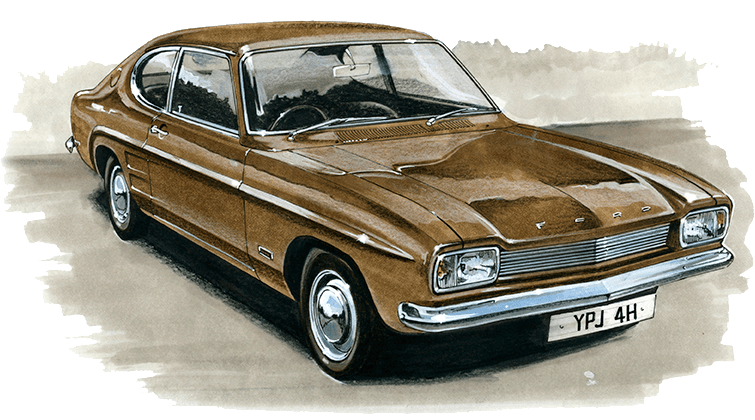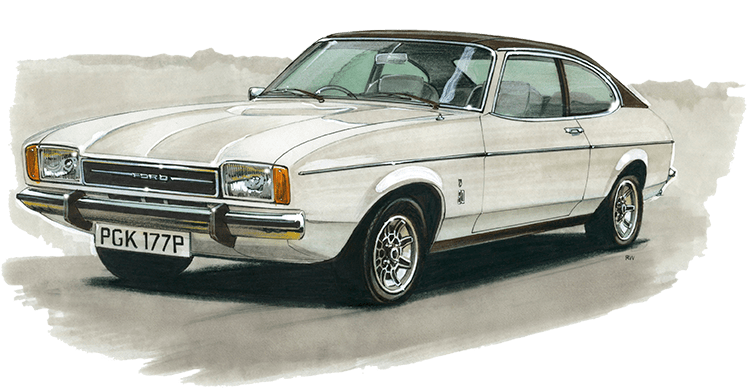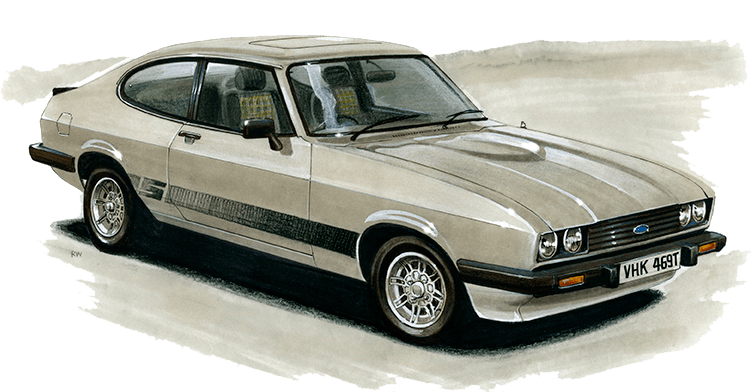
After the success of American made Ford Mustang that has become one of the most popular cars among young people, as well as the first Ford made car with a sporty feel, the “Project Colt” was introduced in Britain in 1965 with the aim to design a car that will create the similar sporty feel but for the British market.
At that time, it was only Lotus Cortina on British market that was considered as a vaguely sporty car. That is why Ford believed that their new project will be as successful as it was in the US. It took two years to draw the style and design for the “Project Colt” and in 1966 the new car was shown to the audience. Later that year, in July, £20 million was allocated to the production and in 1968 the car was released. Still, as the name “Colt” was already registered by the Japanese car manufacturer Mitsubishi, the car was called “Capri”.
Working prototypes being introduced to the public were powered by 1.3 to 2.0-litre engines. Actually, these prototypes were similar to final Capri, having all its features except the famous elliptical rear window. What is more, the 1969′ Capri models shared some of the items with other models manufactured by Ford, such as Ford Cortina, Corsair, and Escort.
Mk I
After the sensational success of Capri in Europe and Mustang in America, Ford started the production at Halewood in Liverpool in 1968. After a year, by February 5, 1969, there was at least one Capri model for every Ford dealer in the country. The Capri, known as “the car you always promised yourself”, was sold like hot cupcakes. Over the period of 18 years of its production, about 2 million cars were sold. The success of the Capri provided the Ford 11 years in the top ten of best-selling cars in Britain. Can you imagine such success today?
Ford Capri has become one of the most desirable cars in Britain. The success of the car was noticed by such famous people as Jackie Stewart and Cliff Richard, known as the drivers of this legend at one time or another. The Capri was so brilliantly successful, that it opened the Ford a part of the market it had never been before.

Mk II
Over a million Ford Capri cars were sold by 1973. Still, as sales rates began to drop, the company decided to release a new model – the Mk II. The project, for some unknown reason, was called “Diana” and the Mk II was introduced on February 28, 1974. It was available in six variations starting from the base 1300L to 3000 Ghia.
The new MkII was even more practical than its predecessor. Still, the main difference between the MkI and the MkII was the hatchback. The design was renewed in evolutionary perspective. It was longer, wider and taller than MkI.
Though 151 modifications were made, the MkII was quite similar to MkI mechanically. Among the main improvements were the rear tracks, bigger brakes, softening of the suspension. Also, the four-cylinder engine was replaced by the new “Pinto” engine.
The main renovation accent was put on design, both interior, and exterior. At the top of the range, there was a model “Ghia”. The X, L and R systems of Ford Capri MkI were replaced by L, GL, XL and GT. Still, there were options of the automatic gearbox as well.
The same to its predecessor, the MkII saw a range of special editions and improvements.

Mk III
The final changes to the Capri were made in March 1978 when the Mk III model was released. Actually, it was never officially called the Mk III as the original name of the project was “Carla”. Still, among Ford lovers and enthusiasts the name was Mk III.
The new model was improved to become more aerodynamic. That is why the main focus was made on the front of the car with unique quad headlamps and louvered grille, extending the leading edge to the bonnet. Among the most significant external changes were plastic side moldings along the doors, as well as a plastic boot mounted rear spoiler. Also, the car was available in new trim colors.

When it comes to mechanical part, the car saw a few important improvements such as the upgraded suspension and thicker anti-roll bars on the sports models. Though the engine remained the same, to the 1300 and 2.0 Litre saw some improvements as well.
The range of trim models was the same to MkII with the Ghia model at the top and the “S” sports model available.
As well as previous models of the Capri, during the period of MkIII’s production, it saw many changes. The last model available was the Capri 280 “Brooklands”.
Top questions about Ford Capri (FAQ):
- When was the Ford Capri first introduced?
- What were the different generations of the Ford Capri?
- What were the available engine options for the Ford Capri?
- How much did the Ford Capri cost when it was first released?
- What was the top speed of the Ford Capri?
- How many units of the Ford Capri were produced?
- Were there any limited edition models of the Ford Capri?
- What were some iconic features or design elements of the Ford Capri?
- How did the Ford Capri compare to its competitors in terms of performance?
- Did the Ford Capri have any notable racing or motorsport achievements?
- How did the Ford Capri evolve over its production years?
- What were some common issues or problems faced by Ford Capri owners?
- Has the Ford Capri gained any collectible or vintage status over the years?
- Were there any notable collaborations or partnerships involving the Ford Capri?
- How did the Ford Capri contribute to Ford’s overall sales and market presence?
- Are there any notable modifications or aftermarket options available for the Ford Capri?
- What were some popular promotional or advertising campaigns for the Ford Capri?
- How did the Ford Capri differ in various international markets?
- Did Ford discontinue the Capri, and if so, why?
- What is the current market value of a well-maintained Ford Capri?
- Another questions